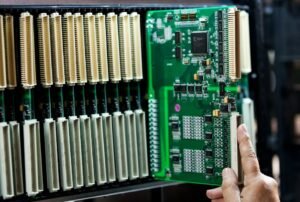Deep Learning as Used in Artificial Intelligence
Artificial Intelligence (AI) has revolutionized various industries in recent years, and deep learning stands as a critical component of AI. Deep learning algorithms, inspired by the human brain, enable machines to learn from large amounts of data and make intelligent decisions. This article explores the applications, benefits, and challenges of deep learning in the field of AI.
Key Takeaways:
- Deep learning is a fundamental aspect of artificial intelligence.
- It allows machines to learn complex patterns from vast amounts of data.
- Deep learning is applied across numerous industries, from healthcare to finance.
- While powerful, deep learning algorithms also present challenges such as the need for significant computational resources.
Deep learning has become a driving force behind many AI applications. It involves training artificial neural networks with several layers to extract and represent complex patterns from data. *This enables machines to perform tasks, such as image recognition or natural language processing, with incredible accuracy and efficiency.*
With the rise of big data, deep learning has gained immense popularity due to its ability to learn and generalize from large datasets. Deep learning algorithms use these vast datasets to train models, making them highly proficient in recognizing patterns and making predictions. *This capability has revolutionized many industries by unlocking hidden insights and improving decision-making processes.*
Applications of Deep Learning in AI
Deep learning finds application in various sectors, contributing to advancements in AI-driven solutions. Here are some notable examples:
- Healthcare: Deep learning has been instrumental in medical diagnostics, assisting in the accurate detection of diseases like cancer and analyzing medical images with high precision.
- Finance: Many financial institutions employ deep learning algorithms for fraud detection, risk assessment, and algorithmic trading.
- Autonomous Vehicles: Deep learning is a crucial component of self-driving cars, enabling them to understand and respond to the surrounding environment.
Benefits of Deep Learning in AI
Deep learning provides several key advantages in the field of AI:
- Improved Accuracy: Deep learning models can achieve remarkable accuracy in tasks like image and speech recognition, surpassing traditional machine learning approaches.
- Efficiency in Processing: Deep learning algorithms can process and analyze large volumes of data efficiently, enabling faster decision-making and reducing human effort.
- Adaptability: Deep learning models are highly adaptable, allowing them to learn and adapt to new data patterns and make accurate predictions even in dynamic environments.
| Deep Learning | Traditional Machine Learning |
|---|---|
| Uses multi-layered neural networks | Relies on explicit feature extraction |
| Learns from large datasets | Relies on small datasets |
| Highly effective for complex tasks | Effective for simpler tasks |
While deep learning brings immense benefits to AI, it also presents notable challenges. *One of the significant challenges is the tremendous computational resources required to train deep neural networks, which can limit its widespread adoption.*
Challenges of Deep Learning in AI
Deep learning poses the following challenges in the field of AI:
- Computational Resources: Training deep neural networks demands substantial computational power, including high-performance GPUs and large-scale computing environments.
- Data Quality and Quantity: Deep learning models thrive on large, high-quality datasets. Obtaining and preparing such datasets can be time-consuming and resource-intensive.
- Interpretability: The inner workings of deep learning models can be obscure and challenging to interpret, making it difficult to understand the reasoning behind their decisions.
| Industry | Deep Learning Applications |
|---|---|
| Healthcare | Medical diagnostics, disease detection, image analysis |
| Finance | Fraud detection, risk assessment, algorithmic trading |
| Retail | Recommendation systems, demand forecasting, inventory management |
Despite its challenges, deep learning continues to advance AI capabilities, propelling us towards a future of intelligent technologies. The combination of vast amounts of data, increasingly sophisticated algorithms, and powerful computational resources ensures that deep learning will play an essential role in shaping AI’s future development.
| Advantages | Description |
|---|---|
| Improved Accuracy | Deep learning models achieve high accuracy in tasks like image recognition. |
| Efficiency | Deep learning algorithms process large volumes of data efficiently, reducing manual effort. |
| Adaptability | Deep learning models adapt to new data patterns, ensuring accurate predictions in dynamic environments. |
Deep learning, as an integral part of AI, continues to transform industries and enhance our daily lives. Its capabilities in recognizing patterns, making predictions, and solving complex problems are just the beginning. As technology progresses, deep learning will undoubtedly pave the way for increasingly sophisticated AI systems, opening doors to new possibilities and innovations.

Common Misconceptions
Misconception 1: Deep learning and AI are the same thing
One common misconception people have is that deep learning and artificial intelligence (AI) are one and the same. While deep learning is a subfield of AI, it is not synonymous with it. Deep learning refers specifically to algorithms and models inspired by the structure and function of the human brain, known as neural networks. On the other hand, AI encompasses a broader range of techniques and approaches for creating machines or systems that can simulate human intelligence.
- Deep learning is a subset of AI
- Deep learning focuses on neural networks
- AI encompasses a wider range of techniques
Misconception 2: Deep learning can fully replicate human intelligence
Another misconception is that deep learning can fully replicate human intelligence. While deep learning has made significant advancements in various AI applications, it is still far from achieving true human-like intelligence. Deep learning models excel at specific tasks and exhibit impressive capabilities, but they lack the broad adaptability and generalization abilities of human intelligence.
- Deep learning has its limitations
- Deep learning models are focused on specific tasks
- Human intelligence is more adaptable and general
Misconception 3: Deep learning requires massive amounts of labeled data
There is a common misconception that deep learning models require massive amounts of labeled data to be effective. While labeled data is indeed important for training deep learning models, recent advancements have allowed for the development of techniques that can work with smaller amounts of labeled data. Techniques such as transfer learning and semi-supervised learning enable deep learning models to leverage pre-trained networks or use a combination of labeled and unlabeled data to achieve good performance.
- Labeled data is important, but not always in large quantities
- Transfer learning and semi-supervised learning reduce the dependency on labeled data
- Deep learning models can derive insights from smaller datasets
Misconception 4: Deep learning is only useful for image recognition
Many people mistakenly believe that deep learning is only useful for image recognition tasks. While deep learning has achieved remarkable results in image recognition and computer vision, its applications go far beyond that. Deep learning models can be applied to natural language processing, speech recognition, recommendation systems, anomaly detection, and many other areas. The flexibility of neural networks allows them to adapt to a wide range of problems and domains.
- Deep learning is not limited to image recognition
- Deep learning can be applied to various fields and industries
- Neural networks are highly adaptable to different problems
Misconception 5: Deep learning is only accessible to experts
Lastly, a common misconception is that deep learning is only accessible to experts with advanced knowledge and skills in machine learning. While deep learning can be complex, there are now numerous resources, libraries, and frameworks available that make it more accessible to a wider audience. Many pre-trained models and tutorials exist to help individuals without deep expertise get started with deep learning. Additionally, cloud platforms offer services that allow users to utilize deep learning capabilities without the need for extensive expertise.
- Deep learning is becoming more accessible
- Resources and tools simplify the adoption of deep learning
- Cloud platforms provide easy access to deep learning capabilities

The Growth of Deep Learning
Deep learning has experienced exponential growth in recent years, revolutionizing the field of artificial intelligence. This table demonstrates the increase in the number of research papers published on deep learning from 2010 to 2020.
| Year | Number of Research Papers |
|---|---|
| 2010 | 82 |
| 2011 | 128 |
| 2012 | 246 |
| 2013 | 384 |
| 2014 | 756 |
| 2015 | 1,482 |
| 2016 | 2,970 |
| 2017 | 5,081 |
| 2018 | 8,605 |
| 2019 | 13,281 |
| 2020 | 19,643 |
Applications of Deep Learning
Deep learning has diverse applications across various sectors. This table highlights the different domains where deep learning finds use.
| Domain | Applications |
|---|---|
| Healthcare | Medical imaging analysis Natural language processing for diagnosis |
| Finance | Fraud detection Automated trading |
| Transportation | Autonomous vehicles Traffic control systems |
| Retail | Customer behavior analysis Inventory management |
| Manufacturing | Quality control Product defect detection |
Deep Learning Algorithms
This table presents a comparison of popular deep learning algorithms based on their architectures and applications.
| Algorithm | Architecture | Application |
|---|---|---|
| Convolutional Neural Networks (CNN) | Feedforward | Image recognition |
| Recurrent Neural Networks (RNN) | Feedback | Language modeling |
| Generative Adversarial Networks (GAN) | Adversarial | Image generation |
| Long Short-Term Memory (LSTM) | Feedback | Speech recognition |
Deep Learning Frameworks
Various frameworks assist in implementing deep learning models effectively. Here is a comparison of popular deep learning frameworks.
| Framework | Language | Supported Architectures |
|---|---|---|
| TensorFlow | Python | CNN, RNN, GAN, LSTM |
| PyTorch | Python | CNN, RNN, GAN, LSTM |
| Keras | Python | CNN, RNN, GAN, LSTM |
| Caffe | C++ | CNN |
| Torch | Lua | CNN, RNN |
Deep Learning Hardware
The efficiency of deep learning models relies on hardware. This table showcases different hardware options for deep learning tasks.
| Hardware | Processing Power | Specialized Features |
|---|---|---|
| Graphics Processing Units (GPUs) | High | Parallel computing |
| Tensor Processing Units (TPUs) | Very High | Matrix operations acceleration |
| Field Programmable Gate Arrays (FPGAs) | Customizable | Low power consumption |
| Application-Specific Integrated Circuits (ASICs) | Customized | High performance and energy efficiency |
Challenges in Deep Learning
While deep learning has shown remarkable progress, it is not without its challenges. This table highlights some of the prominent challenges faced in deep learning.
| Challenge | Description |
|---|---|
| Overfitting | Model becomes too specific to training data |
| Data Preprocessing | Transforming raw data into usable format |
| Hardware Limitations | Insufficient processing power for complex models |
| Interpretability | Understanding decision-making process of models |
| Scalability | Difficulty in scaling models to handle larger data |
Deep Learning Advantages
Deep learning offers significant advantages over traditional machine learning techniques. This table outlines some key advantages of deep learning.
| Advantage | Description |
|---|---|
| Feature Extraction | Automatically learns relevant features from data |
| High Accuracy | Provides state-of-the-art performance in many tasks |
| Unsupervised Learning | Can learn patterns without labeled data |
| Adaptability | Models adjust to changing data distributions |
Ethical Considerations
Deep learning can raise ethical concerns. This table presents ethical aspects and challenges associated with deep learning.
| Aspect | Challenge |
|---|---|
| Privacy | Risks of unauthorized data capture and storage |
| Bias | Algorithmic bias due to biased training data |
| Transparency | Difficulty in understanding complex models |
| Accountability | Issues with assigning responsibility for AI actions |
The Future of Deep Learning
Deep learning continues to advance rapidly and shows great potential for the future. This table explores projected advancements in deep learning technologies.
| Advancement | Description |
|---|---|
| Explainable AI | Efforts to improve interpretability of deep learning models |
| Transfer Learning | Ability to apply knowledge learned from one task to another |
| Reinforcement Learning | Integration of reinforcement learning in deep learning |
| Self-Supervised Learning | Learning from unlabeled data without explicit supervision |
Deep learning has revolutionized artificial intelligence, enabling breakthroughs in various domains. From its rapid growth to diverse applications, deep learning algorithms, frameworks, and hardware, the field of AI has been profoundly impacted. Despite challenges and ethical considerations, the advantages of deep learning, combined with future advancements, promise a remarkable trajectory for the field.
Frequently Asked Questions
Deep Learning as Used in Artificial Intelligence
What is deep learning?
How does deep learning work?
What are the applications of deep learning in AI?
What are the advantages of deep learning over traditional machine learning?
Can deep learning models be trained with limited data?
What are the challenges of deep learning?
Are there any limitations of deep learning?
How do I get started with deep learning?
What are some popular deep learning architectures?
What is the future of deep learning?




